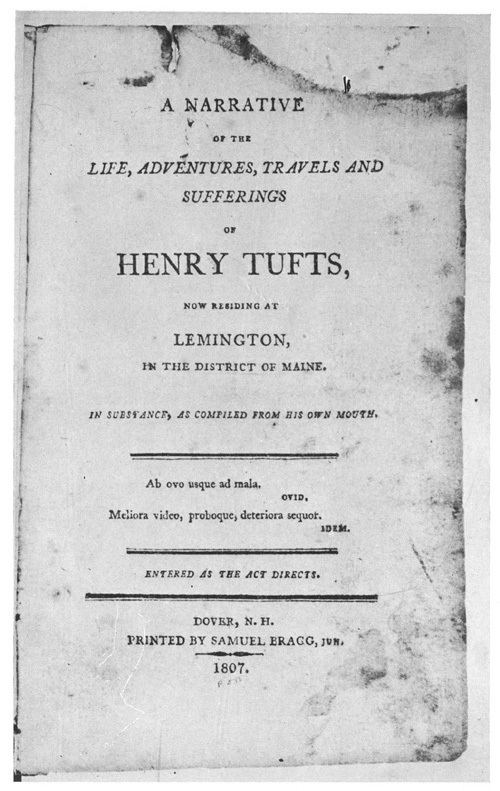Name Henry Tufts | Died 1831 | |
 | ||
Books The Autobiography of a Criminal | ||
Henry Tufts (1748–1831) was an infamous 18th-century thief who committed various crimes in northern New England. Most of what we know about his life and crimes comes from his 1807 autobiography A Narrative of the Life, Adventures, Travels and Sufferings of Henry Tufts, Now Residing at Lemington, in the District of Maine. In Substance as Compiled from his own Mouth.
This autobiography was reprinted in 1930 as Autobiography of a Criminal. Neal Keating's 1993 reprint of Tufts' autobiography summarizes Tufts as a "horse thief, bigamist, burglar, adulterer, con man, scoundrel, counterfeiter, (military) deserter and common criminal.”
"An uncommonly misspent life"
Tufts was born in Newmarket, New Hampshire, in June 1748 to a tailor and his wife. Tufts would grow up in the nearby town of Lee, where he would first exhibit his "natural propensity to theft.”
Tufts began his criminal activities at the age of 14 with thefts of "apples, pears, cucumbers, and other fruits of the earth," and then graduating to "a paper money bill" of a neighbor. He soon went on to stealing horses (which he disguised by coloring them) including the theft and subsequent selling of his own father's horse. The autobiography goes on to list numerous thefts of everything from silver spoons to livestock and clothes. He stole from houses, barns, and stores. He usually sold the stolen objects in neighboring towns.
He married one Lydia Bickford around the age of 22, but would later marry other women without divorcing Lydia.
Tufts was first imprisoned in 1770, where he attempted his first of many escapes by using the cell's heating fire to burn through a wooden wall of the jail.
Many of his jail escapes were accomplished with due small tools concealed on his person or passed to him visits from friends. Not even his fellow prisoners were safe from his sociopathic ways: once he and a fellow prisoner “stripped off all our clothes, turn(ed) them inside out, and (flung) them out” of the small hole Tufts had made in the jail wall. Tufts exited first and, before waiting for his accomplice to follow, “gathered up (his) apparel, which I expected in all likelihood to need…and sped away.”
When imprisoned, Tufts often saw himself as the unfair victim, once commenting on his time in a jail as “in the shocking circumstances…described, I continued for upwards of three months, without aid or assistance from either friend or foe, or so much as the expectation of relief – no eye had pity on me!”
Tufts spent several years among the Abenaki Indians in or near Bethel, Maine and learned their natural medicines from Molly Ockett shortly before his final arrest in 1794 at Marblehead, Massachusetts. Sentenced to hang, his sentence was commuted to life imprisonment by Governor Samuel Adams. After five years imprisoned on Castle Island in Boston Harbor, he was transferred to the jail in Salem, from whence he escaped to Maine. If his autobiography is to be believed, he thereafter lived as a healer and farmer without further criminal misdeeds.
Ultimately, while an entertaining book, it is difficult to tell how much of Tufts' autobiography is completely true. In his foreword to a 1993 reprint of the book, Keating points out that "Henry Tufts' favorite scheme was lying…(and) in his autobiography he lies.…”
